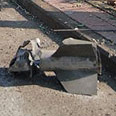
Causing damage
צילום: זאב טרכטמן
Study: Over half of Sderot residents are Qassam casualties
Research published by trauma center indicates large percentage of residents of rocket-plagued town suffering from post-traumatic stress disorder
Over half of Sderot residents have been hurt – physically or emotionally – during Qassam barrages of the past seven years, determined a research document published by Natal, the Israel Trauma Center for Victims of Terror and War.
The study, which was presented by Director of the Natal Community Staff Dr. Rony Berger at a conference on trauma medicine in Beersheva on Monday, shows that almost a third of the beleaguered town's residents are suffering from post-traumatic stress disorder. A third of Sderot students, ages 13 to 18, have trauma-related learning disorders.
The research, conducted in conjunction with Dr. Mina Zemach and the Dahaf Polling Institute, was conceived in order to compare Sderot to Gaza vicinity communities and to towns out of rocket range.
The test group was comprised of Sderot residents, while the control group was comprised by residents of Ofakim – a town with a similar socio-economic makeup but not under constant rocket attack. A group from the Gaza vicinity was also studied.
The study showed that three times as many Sderot residents went to a psychologist or spiritual counselor (such as a rabbi) than did Ofakim residents. Ninety percent of residents had seen or heard a Qassam hit, while 65.3% of them personally knew someone hurt in an attack.
Deteriorating fortifications and coping mechanisms
Almost half of Sderot residents (48.4%) knew someone who had been killed in an attack. Compared to only 39.3% of children in Ofakim, 74.2% percent of children in Sderot from ages 7 to 12 suffer from phobias."The problem in Sderot is not only security-related, but also social," said Berger. "28.4% of Sderot residents are diagnosed with post-traumatic stress disorder, compared to 1.9% in Gaza vicinity communities."
The difference, according to the director, is that "not only are the fortifications in Sderot poorer, but the population is also weaker. The social unity is smaller. It's a population who felt, and still feels, abandoned. And, in my opinion, rightly so."
Despite the seeming greater hardiness of Gaza vicinity residents, the distinction between these communities and Sderot extends only to adults. In Gaza vicinity communities, as well, some three-fourths of the children ages 12-14 suffer from post-traumatic stress disorder, compared to 86.6% in Sderot.
"It's possible to see a growing deterioration in the coping mechanism of Sderot residents," Dr. Berger told Ynet. "Today, with the renewed rocket fire, I predict a lot more problems than in the past."
"The residents' responses to the rocket fire are more extreme than they were in the past," he said.
Dr. Berger stressed the importance of his work in Sderot, noting that "increasing the awareness of the phenomenon of post-traumatic stress allows people to ask for help."
However, he added, "sometimes people think hey have this problem and they don't." He said his work involved a balance between healing and creating a situation in which not every Sderot resident thought he or she was suffering from an emotional disorder.










